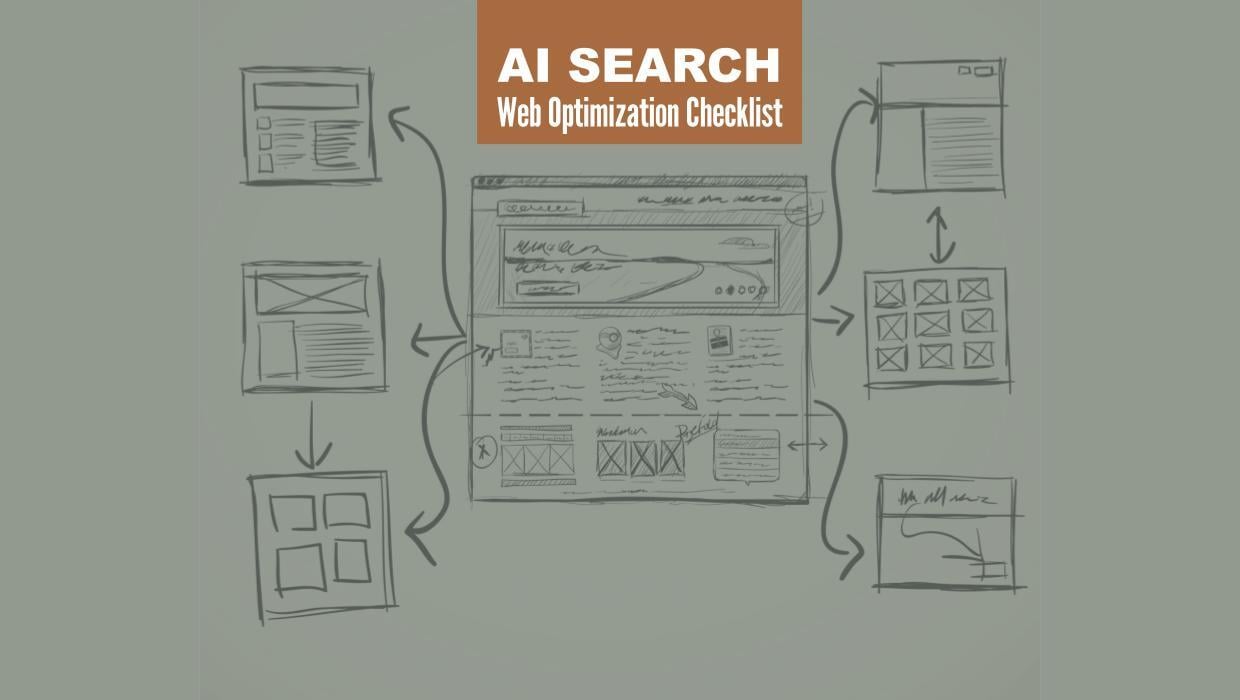Audience Research in the Age of AI: Turning Data into Marketing Advantage
Written by
Buyers hold more power, third-party tracking privacy rules are stricter, and algorithms shift constantly. Meanwhile, content translated or written by AI has exploded, accounting for an estimated 57% of all web-based text. Amid the noise, assumptions about who your buyers are and what they care about can quietly drain your budget. In fact, research shows that up to 37% of your marketing spend could be wasted if it’s based on outdated or incomplete insights.
In Episode 28 of The ChangeOver Podcast, Jo Phillip and I dive into the state of audience research in the age of AI. We unpack the forces reshaping buyer behavior, share overlooked data sources of insight, and explain how B2B marketers can combine AI-based tools with human critical thinking and empathy to make better informed strategic decisions and maximize ROI.
Watch episode 28 of The ChangeOver, then subscribe on Apple, YouTube, Spotify, Weidert.com, or your favorite podcast app.
Why Do Traditional Approaches Fall Short?
Personas have been the longstanding tool used by marketers to guide campaigns and strategies. Once created, however, personas are rarely updated or consulted, which is a problem if they were originally intended to be a marketing guidepost.
Further, personas were largely based on anecdotal feedback from sales teams or generalized “best practices” that provided limited value then, and certainly lack the depth and agility marketers need now.
The result? One-dimensional profiles that don’t reflect the current state of how buyers research, evaluate, and make decisions.
“Best practices and static personas aren’t enough anymore. Your campaigns need to be built on real-time data about your actual buyers, in your actual market.”
Dynamic audience profiles evolve continuously and draw from several data streams of real-world evidence that capture:
- Behavioral data (actual buyer actions vs. assumed buyer actions)
- Contextual data (industry, role, and company structure)
- Emotional drivers that influence decisions (fears, motivations, expectations)
It’s a new and necessary approach to audience research, but it doesn’t require starting from scratch. Instead, it requires rethinking how you use data at your fingertips.
Many of the richest insights are already in-house, waiting to be accessed and applied to your B2B marketing strategy.
Internal Data Sources: Do you already have the insights you need?
One of the biggest missed opportunities is the data companies already collect but underutilize. When carefully parsed and analyzed, these internal data sources reveal patterns that may well change how you market, sell, and succeed:
CRM Data
CRM systems are vital for segmentation and reporting, but the often overlooked value is in comparing behaviors across deals won and lost. Which job titles appear most often in deals you close versus those you lose? How fast do different industries move through your pipeline? These insights can reshape persona profiles and influence budget allocation.
Website Analytics
Website metrics don’t stop at traffic or bounce rate. Digging into and comparing time-on-page with exit rates can reveal whether content is engaging buyers and prompting next steps, or primarily attracting influencers and amplifiers. Navigation paths reflect what visitors do after engaging with content, and can indicate buying intent based on where they go next. When segmented by role, industry, or source, this data helps marketers see how content performs overall, and how well it reaches the right audience.
RELATED: The Evolving Role of B2B Websites in Marketing
Voice of Customer (VoC)
Feedback doesn’t only come from surveys. Free-form responses on web forms, service call transcripts, and product reviews all contain straight-from-the-source language. Collective analysis of these voice of customer insights are critical in identifying the real questions, objections, and priorities buyers have throughout their journey.
As Jo put it in our conversation:
“We always say ‘talk to your customers,’ but it’s more than that. It’s looking at what they write in form fills, the way they phrase their problems, and even the objections they bring up on calls. That’s their voice, and marketers should be using it.”
Subject Matter Expert (SME) Knowledge
Many employees in your organization interact with customers every day. Engineers, service reps, and frontline salespeople hear unfiltered questions, objections, and success stories that all too often remain confined to these one-on-one conversations.
Implementing structured internal workshops where your SMEs can share their firsthand knowledge is a data mining opportunity that can reveal behavioral patterns behind purchase decisions. Taking it one step further by synthesizing the information with help from AI tools can distill data into recurring themes and topics that inform editorial calendars and produce content that resonates with your audience.
RELATED: How To Win At B2B Thought Leadership — with guest Jay Acunzo
External Data Sources: How do AI tools in B2B marketing help paint the big picture?
Internal data demonstrates how buyers engage specifically with your company. External data shows how they behave in the wider marketplace. Combined, these sources provide a full-circle view of your audience.
Think of external data as layered on top of internal data. Yes, you have more data, but you also have more objective perspectives. From there, it’s a matter of understanding where to look, what to look for, and ultimately leveraging AI to understand and apply this new-found knowledge.
Four primary sources for gathering external inputs include:
- SEO Research: Keyword data is a proxy for buyer intent. High-impression, low-click keywords reveal where content is being seen but it’s not compelling enough to earn engagement. The resulting gaps are actually opportunities to fine tune metadata, headlines, resources, etc., to better match search intent. With the help of AI tools, terms can be clustered into themes, and themes into content that addresses what your audience is asking throughout their journey
- Online Reviews: Reviews on third-party sites and industry platforms provide unfiltered feedback in the buyer’s own words. Competitor reviews are especially valuable because they reveal recurring frustrations, unmet expectations, and the differentiators customers truly care about. From it, patterns will emerge — not just about product features, but about what audiences value most. Mirroring their language is marketing-ready: messaging feels authentic and signals to prospects that you actually understand their priorities
- Clickstream Data: Audience research tools like SparkToro aggregate browsing behaviors, showing you which podcasts, forums,websites, and social accounts your audience frequents. Measurable data takes the guesswork out of distribution. Instead of assuming which channels matter, you can see what your buyers already trust. In turn, you can focus your marketing efforts where your audience’s attention is already going and prioritize budget accordingly
- Social Listening: Reddit threads, LinkedIn posts, and niche forums surface candid opinions buyers rarely share in a sales conversation. These forums surface frustrations, misconceptions, and even “taboo” questions that prospects may be uncomfortable asking a vendor directly. If you’re paying attention, social listening for B2B is a source of content gold
Why the Human Element Still Matters in Audience Research
AI has transformed the way marketers can approach audience research. It can pull patterns from unstructured data in minutes, surface anomalies that might otherwise go unnoticed, and scale analysis at a pace humans could never match. For teams short on time or resources, that’s game-changing.
But Jo stressed that AI alone isn’t enough. “Your most elegant strategy will fall apart if it’s based on assumptions instead of evidence. The path forward is connecting the dots and layering human thinking on top of AI-powered analysis.”
Data without human interpretation risks becoming shallow, misapplied, or even misleading. Machines can organize, but they can’t prioritize. They can find connections, but they can’t decide which matters most to your business or industry. And they certainly can’t empathize with the human experience behind the numbers.
What does AI do well?
- Sift through massive, messy datasets
- Highlight recurring patterns or anomalies
- Suggest potential correlations worth exploring
How do humans top AI?
- Apply context drawn from industry knowledge and customer relationships
- Weigh trade-offs, balancing what’s possible with what’s practical
- Infuse messaging with empathy, nuance, and creativity that resonates with real buyers
AI tools make data collection and analysis faster and more accessible, but human judgment remains irreplaceable.
Take the First Step
Audience research in the AI era is about balance. By pairing the speed of AI with human critical thinking and empathy, marketers can build dynamic buyer personas, reduce wasted spend, and create strategies that actually resonate.
With nearly 40% of your budget effectiveness at stake, the question isn’t whether to evolve your approach, but how quickly you can begin.
Catch the full conversation between Jo and me on The ChangeOver Podcast, and subscribe to explore even more strategies and straight talk for today’s industrial marketers.
Subscribe To Our Blog
Information. Insights. Ideas. Get notified every time a new Weidert Group blog article is published – subscribe now!
You May Also Like...

Search Engine Optimization
Optimize Your Industrial Website for AI Search

Marketing Technology
Why Unified Data Efforts Fail (and How Manufacturers Can Fix It)

Search Engine Optimization
How Falcon Rebuilt Industrial AI Search Visibility in 2025
Accelerate Your Growth with
Weidert Group
If you’re ready to explore a partnership, request a personalized consultation with our team.

